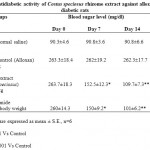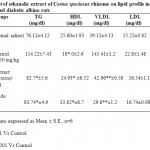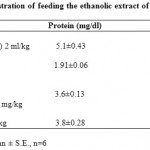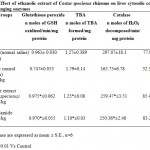Manuscript accepted on : 19 November 2011
Published online on: --
J. Revathy, S. P. Sangamithira, S. Sheik Abdulla* and P. Sampath Kumar
Biochemistry Faculty, Department of Chemistry and Biosciences, SASTRA University, Srinivasa Ramanujan Centre, Kumbakonam - 612 001 India.
ABSTRACT: The antidiabetic effect of ethanolic extract of Costus speciosus rhizome was determined. Various secondary metabolites were also identified and quantified by HPLC analysis. The antioxidant activity is determined by hydrogen peroxide and phosphomolybdate methods. The animals were divided into four groups such as normal, diabetic untreated, diabetic treated with ethanolic extract and diabetic treated with reference drug Glibenclamide. The ethanolic extract of Costus speciosus rhizome (200mg/kg body weight/rat/day) was given to the rats for 15 days orally. Blood samples were collected by retro orbital puncture and various biochemical parameters were measured using autoanalyser. The ethanolic extract shows significant reduction in blood glucose, glycosylated haemoglobin, blood urea, serum uric acid, serum creatinine, triglycerides, total cholesterol, phospholipids, low density lipoprotein (LDL), very low density lipoprotein (VLDL), and increase in liver glycogen, insulin and lactate dehydrogenase (LDH). Our experimental findings with respect to the mechanism of action of extract in alloxan induced diabetic rats suggest that it enhances insulin secretion by the islets of langerhans, enhances peripheral glucose utilization and increases serum protein levels.
KEYWORDS: Thiobarbituric acid (TBA); Superoxide dismutase (SOD); Costus speciosus; Alloxan; Glibenclamide
Download this article as:| Copy the following to cite this article: Revathy J, Sangamithira S. P, Abdulla S. S, Kumar P. S. An Experimental Evaluation of the Antidiabetic and Antioxidant Effect of Costus speciosus Rhizome Extract in Alloxan Induced Albino rats. Biosci Biotech Res Asia 2011;8(2) |
| Copy the following to cite this URL: Revathy J, Sangamithira S. P, Abdulla S. S, Kumar P. S. An Experimental Evaluation of the Antidiabetic and Antioxidant Effect of Costus speciosus Rhizome Extract in Alloxan Induced Albino rats. Biosci Biotech Res Asia 2011;8(2). Available from: https://www.biotech-asia.org/?p=9640 |
Introduction
Diabetes is a metabolic disorder characterized by impaired glucose utilization and is the underlying factor for both hypoglycaemia and hyperglycaemia. Chronic hyperglycaemia results in impaired function or failure of various organs, especially the eyes, kidneys, nerves, heart and blood vessels. Despite advances in medicine, diabetes as a major health complication seems to be growing at an alarming proportion world over and in India, in particular. By the end of 2030, 79.4 million Indians are expected to be affected by this metabolic disorder and this accounts for nearly one-sixth of the world’s diabetics1. Plant drugs are frequently considered to be less toxic and more free from side effects than synthetic ones. In the traditional system of Indian medicine plant formulation and in several cases, combined extracts of plants are used as the drug of choice rather than individual. Many of these have shown promising effects. Various herbal formulations like D-400 and Trasina are well known for their antidiabetic effects2. Nearly 100 polysaccharides from plants have been reported to have hypoglycemic activity.
Costus speciosus is a spiral, crepe or wild ginger belongs to the family costaceae. It is an important source of diosogenin and is used in many human and vetinary medicines. It is bitter, astringent, cooling, digestive, stimulant and good for the heart. It cures kapha and pitta disorders, dyspepsia, fever, cough and other respiratory diseases, diabetes, oedema, blood diseases, leprosy, and other skin ailments. An aqueous extract of C.speciosus rhizome part showed significant hypoglycemic effects when it was administered orally with a simultaneous glucose load3. The present study is aimed to analyse the phytoconstituents and to determine the antioxidant activity and to assess the influence of oral administration of ethanolic extract of C.speciosus rhizome on the levels of biochemical parameters and activities of enzymes in alloxan induced diabetes rats.
Materials and Methods
Collection of plant Material
The plant material for the present investigation was collected from the field areas of Kumbakonam, Thanjavur District, Tamilnadu, India.
Plant extraction
Soxhlet apparatus is a method to extract a soluble fraction from a solid medium. This apparatus consists of condenser, an extraction unit and a round bottom flask. It has a standard paper round glass joints. The extraction unit and control unit plays a vital role in this apparatus.
The shade dried coarsely powder of rhizome of Costus speciosus about 100g was weighed and placed inside the extraction unit. The flask was filled with solvent (100% ethanol) about 250ml was switched on, and after few hours (approximately four cycles) it was switched off, the extract was collected from the flask. Then the evaporated final content was used for the phytochemical work and for animal treatment.
Phytochemical Analysis
Phytochemical analysis was carried out qualitatively to identify the presence of various secondary metabolites such as alkaloids, flavanoids, tannins, phenols, steroids, glycosides, carbohydrates, aminoacids, proteins, saponins, terpenoids, ascorbic acid, coumarin, quinones and sulphur4.
Determination of antioxidant
The antioxidants are determined by using hydrogen peroxide scavenging assay and phosphomolybdate method5.
Animal management
Wistar Albino rats (150-180gms) were selected for these studies. Six rats were taken for each group. The rats were used after an acclimatization period of 7 days to the laboratory environment (obtained from Periyar pharmaceutical institute, Trichy).The animals were maintained in a control environment. They were provided with food and water adlibitum.
Source of Chemicals
Alloxan chemical analytical grade was purchased from SD fine Chemicals Pvt. Ltd., Biosar. All other chemicals used, were obtained from Ranbaxy Research Laboratories, Glaxo Laboratories and Nice Pharmaceutical Company, India.
Induction of hyperglycemia by alloxan
Hyperglycemia was induced by intra peritoneal injection of freshly prepared aqueous solution of alloxan monohydrate (SD fine Chemicals Pvt. Ltd., Biosar) 150mg /kg, to overnight fasted rats. Control rats receive similar volume of vehicle, normal saline (2 ml/kg body weight) alone. Animals that did not develop hyperglycaemia after 48 hrs of alloxan injection were rejected and new animals were used. Immediately after confirmation of diabetes, rats were classified into four groups of five rats each.
Treatment group protocol
The animals were divided into four groups and each consists of five animals.
Group I – received normal saline and served as control.
Group II- treated with alloxan monohydrate 150 mg/kg served as diabetic control.
Group III –treated with ethanolic rhizome extract (200mg/kg)
Group IV- treated with glibenclamide (2.5mg/kg) and served as reference standard.
Drug administration
Hyperglycemic rats were treated using ethanol extract of Costus speciosus dissolved in Tween 40, through oral administration.
Collection of blood sample
At the end of the experimental periods, the rats were sacrificed. Plasma and serum were separated. Treatment continued for 14 consecutive days. Before the treatment (0 day) and at the end of 7th and 14th day plasma levels of glucose were estimated using the glucose oxidase method. At the end of the experimental periods, the rats were sacrificed. Plasma and serum were separated from blood by centrifuging the samples at 5000 rpm for 10 min and stored in a refrigerator until analysed.
Biochemical Analysis
Blood samples were examined to determine plasma glucose6 and the serum concentrations of triglycerides (TG), high density lipoprotein (HDL), very low density lipoprotein (VLDL), low density lipoprotein (LDL), total cholesterol (TC), protein and urea were determined using commercial kits. The liver cytosolic contents of thiobarbituric acid reactive substance (TBA), Glutathione peroxide and ROS scavenging enzymes such as catalase and superoxide dismutase (SOD) were also determined using autoanalyser.
Statistical analysis
Results were statistically analysed by mean ± standard error. Significance between groups was estimated using student’t’ test7.
Results and Discussion
Various phytochemicals such as alkaloids, flavanoids, tannins, phenols, steroids, glycosides, carbohydrates, aminoacids, proteins, saponins, terpenoids, ascorbic acid, coumarin, quinones, sulphur shows positive inference. They may help to prevent diseases like cancer and heart diseases besides their role to inhibit the microorganisms causing many diseases in human beings.
Radical scavenging effect of Costus specious of various concentrations are determined by using hydrogen peroxide method and phosphomolybdate method and the inhibition concentrations are found to be greater. Flavanoids and other phenolic compounds have been reported as scavengers of free radicals and reduce the damage due to oxidants by neutralizing the free radicals before they can attack the cells and prevent the damage to lipids, proteins, enzymes, carbohydrates and DNA.
Table 1: Revealed that diabetes mellitus increases the plasma glucose level, gradually which is due to insulin dysfunction. The effect of ethanolic extract of rhizome of C.speciosus on the blood glucose level of experimental animals was determined at various day intervals such as 0, 7 and 14. After oral administration (200mg/kg) of rhizome extract, there was a significant elevation in the plasma glucose level by 2-3 times during experimental time periods in alloxan induced diabetic rats, when compared to normal rats. Increased levels of plasma glucose in alloxan induced diabetic rats were lowered by the administration of C.speciosus ethanolic extract. The result indicates that overall blood glucose control is improved due to improvement in insulin secretion8.
 |
Table 1: Antidiabetic activity of Costus speciosus rhizome extract against alloxan-induced diabetic rats.
|
Table 2: Shown high levels of total cholesterol, TG and more importantly LDL cholesterol in the blood are major coronary risk factors. Acute insulin deficiency initially causes an increase in free fatty acid mobilization from adipose tissue. This results in increased production of cholesterol rich LDL particles. HDL is an antiatherogenic lipoprotein. It transports cholesterol from peripheral tissue into the liver and thereby acts as a protective factor against coronary heart disease. The level of HDL cholesterol, which increased after C.speciosus ethanolic extract administration, might be due to the increase in the activity of lecithin cholesterol acyl transferase, which may contribute to the regulation of blood lipids9.
 |
Table 2: Effect of ethanolic extract of Costus speciosus rhizome on lipid profile in normal and Alloxan induced diabetic albino rats.
|
Table 3: From table 3 it is evident that hyperglycemia induces elevation of serum urea leading to renal dysfunction. The present study found that the administration of the C.speciosus rhizome extract increased the total protein as compared with normal levels10.
 |
Table 3: Effect of administration of feeding the ethanolic extract of Costus speciosus on serum protein and urea.
|
Table 4: The concentrations of liver cytosolic enzymes were significantly increased after the induction of diabetes, whereas administration C.speciosus rhizome extract decreased the level of TBA and reverted the GSH level to normal in diabetic rats, suggesting an increased protection against oxidative stress in these animals11. Present study suggest that ethanolic extract C.speciosus could be used to improve the glucose and lipid metabolism as to reduce the imbalance between the generation of ROS and the scavenging enzyme activity in diabetic conditions12. Selective damage of islet cells in type I diabetes could be due to low levels of antioxidant enzymes SOD and catalase in the pancreas.
 |
Table 4: Effect of ethanolic extract of Costus speciosus rhizome on liver cytosolic contents and ROS scavenging enzymes.
|
Acknowledgement
The authors would like to thank the professors, lecturers and the lab technician of the Department of Chemistry and Biosciences, SASTRA University, Srinivasa Ramanujan Centre, Kumbakonam for their support during the work.
References
- Susheela, T., Padma Balaravi., Jane Theophilus., Narender Reddy T., and Reddy, P.U.M. Evaluation of hypoglycaemic and antidiabetic effect of Meliadubai CAV fruit in mice. Current science, 94, 1191-1195, (2008).
- Pari, L. and Saravanan, G. Antidiabetic effect of Cogent db, a herbal drug in alloxan-induced diabetes mellitus. Comparative Biochemistry and Physiology Part C 131 19-25 (2002).
- Pitchai Daisy, James Eliza, and Savarimuthu Ignacimuthu. Influence of Costus speciosus (Koen.) Sm. Rhizome extracts on biochemical parameters in streptozotocin induced diabetic rats. Journal of Health science, 54(6), 675-681, (2008).
- Gopiesh Khanna, V., and Kannabiran, K., Larvicidal effect of Hemidesmus indicus, Gymnema sylvestre and Eclipta prostrata against Culex qinquifaciatus mosquito larvae. African Journal of Biotechnology6 (3) pp 307-311, (2006).
- Umamaheswari, M., and Chatterjee, T.K., In vitro antioxidant activities of the fractions of Coccinia grandisLeaf extract. African J.Traditional CAM (000) 5(1): 61-73, (2008).
- Trinder, P. Determination of glucose in blood using oxidase with an alternative oxygen acceptor. Clin. Biochem., 6, 24-27, (1969).
- Snedeeor G.W., and Cochran W.G., in “Statistical Methods”, Oxford and IBH Publishing Co., New Delhi, 33 (1997).
- Kim, S.H., Hyun, S.H., and Choung, S.Y., Antidiabetic effect of cinnamon extract on blood glucose in db/db mice. Ethnopharmacol., 104, 119-123, (2006).
- Colca, J.R., Insulin sensitizer may prevent metabolic inflammation. Pharmacol., 72, 125-131, (2006).
- Patil, U.K., Saraf, S., and Dixit, V.K., Hypolipidemic activity of seeds of Cassia tora J.Ethnopharmacol., 90, 249-252, (2004).
- Venugopal, S.K., Devaraj, S., Yang, T., and Jialal I., Diabetes, 51, 3049-3054, (2002).
- Zhang, H., Matsuda, H., Kumahara, A., Ito, Y., Nakamura, S., and Yoshikawa, M., Med.Chem.Lett., 17, 4972-4976, (2007).

This work is licensed under a Creative Commons Attribution 4.0 International License.





